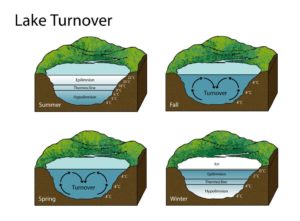As I’ve discovered since first writing for “The Boardwalk,” whenever I begin with a seemingly simple question about nature, I end up learning more than I ever expected. This week, I was wondering how fish survive under the layer of ice on our lakes. From that, I delved into the fascinating world of fish physiology, oxygen, ice and limnology, which is the study of the biological, chemical, and physical features of lakes and other bodies of fresh water. I literally had no idea this field existed. All of these topics are co-dependent (in the good way) when it comes to finding an answer to my initial question.
First, as we all know, fish do not come to the surface to breathe air. Instead, they take in “dissolved” oxygen from the water. So, if the surface is frozen, where does their oxygen come from? Since ice is porous, it does not create an air-tight seal. Heavy gas molecules such as oxygen can penetrate the ice and dissolve into the water while other gases are pushed out. Oxygen is also created by the decomposition of organic matter on the lake’s bottom, and it’s brought in by streams, rivers and springs.
Even with those sources, the amount of oxygen does drop off when our scaled neighbors’ home is capped in ice. To cope with this, most fish slow down their metabolism, which lessens the amount of oxygen and food they require. They also reduce their activity level. Some species will move sluggishly, while others hunker down almost to the point of hibernation. For example, bluegill won’t eat all winter long, relying on fat stores they accumulated in the fall. Then, there are those wily, cold lovin’ fish that inhabit our lakes. Trout remain fairly active throughout the winter; in fact, the cooler water allows them to venture into the shallower depths they can’t tolerate in the summer. Hence, the advent of ice fishing contests.
But why don’t they become ice-encrusted fish sticks in these frozen waters? Aaaah, now we get into the fascinating ecosystem of a lake. In the summer, lakes are colder the deeper one goes. But in the winter, the exact opposite is true. Our thermally stratified lakes have a warm upper layer (epilimnion), a middle region (metalimnion) with a point called a thermocline, which is the transition where the water becomes very cool. The cold, dark, lower part of the lake is the hypolimnion. Our lakes are dimictic, meaning they turn over in the fall and spring. The fall turnover happens when the upper layer of water gets cold enough to make it so dense, it sinks below the middle and lower layers that haven’t cooled yet. This pushes up the warmer, lower water which, in essence, turns over the lake’s layers. In the winter, fish can survive in the deepest part of the lake where the water is cool, but still unfrozen.
Who’d a thunk it? I ponder about fish and become versed in limnology.

Originally published in The Boardwalk newspaper, Grand Lake, Colorado.